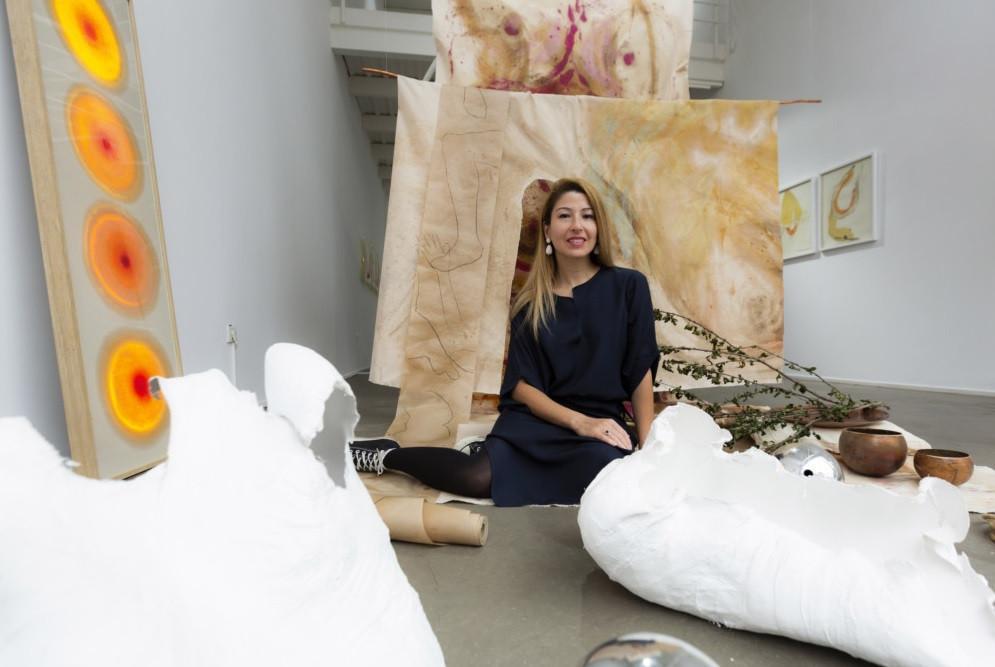
Nazlı Gürlek Hodder’s creative process is an instinctive and unconditioned path. Her urge to create is like a primitive instinct coming from her soul and her body. That’s how her works reflect primitive and sentient drawings and installations. She reflects onto body and soul connection depicting how both the body and mind are a collaboration of sentiments, through creativity.
According to the artist, art and painting is a process of exploration and healing. It is not a representation nor news or a message. Because Gürlek’s way of understating and creating art is a process through which what is inside is expressed and gains social relevance. It is the path, mark, memory, sign, and guide of real-life processes, said Gürlek.
She uses her works as a metaphysical question of being as becoming one as a whole with her body. That’s how she manages to tell her journey through her solo show at the Istanbul art space of Evliyagil Dolapdere titled “In the Body.” Somehow, she shows us how the body is part of our soul and how the soul is a part of the body and these are two inseparable concepts. This is a journey of finding oneself and discovering her realities.
This is a long journey, according to Gürlek. “The moment I realized things were not right for me in life in my mid-30s and decided to transform them was the moment I realized how separate I was from my own body. This means being disconnected from feelings, emotions, instincts too, all of which have a huge part in the healthy functioning of an individual.”
Gürlek said this is not a story specific to her alone but a general problem common to the majority of the society. “This is a problem rooted in our very own social constructs and it dominates the lives of many of us,” she added. What Gürlek wants everyone to understand is how constraints, the patriarchal order we live in and, the things we experience in everyday life separates us from our own beings [bodies]. And this affects how we live, how we create, and how we become a part of the collective, in short, how we perceive the “whole” in life.
Spiritual dimensions, remnants of Çatalhöyük
The exhibition explores why we should be aware of our existence and opens a path to see the body inside the mind just the way Yoga Sutra of Patanjali explains. That’s why the exhibition is also experiencing the body in a way like experiencing art.
“We have to get rid of the burden that our bodies bear for all centuries if we want to lead a life that we build with our own truths, with own voice and life purpose,” she said. “My belief is that only in this way can we make significant contributions to life. So, what I am talking about here is a process involving healing as well as alchemy and creativity.”
Art for the artist on the other hand is nothing but the unity of healing, alchemy, and creativity, and the artist is very similar to an alchemist and a healer.
That’s how her paintings are created as a trace of performative process that was developed at the moment she found the courage to initiate a journey back into her body. In a way, she creates and rebuilds her artistic language, and in this artistic language that she combines elements from Anatolian and Central Asian shamanic cultures with dance therapy techniques and archaic symbolism. She works through a ritualistic process in which she merges all these different elements instinctively. Through these rituals, she explores material, emotional and spiritual dimensions of her body
During her journey, Gürlek’s path has opened many different experiences in terms of art. However, among them, Çatalhöyük is an intriguing and significant one.
Gürlek said she has been intuiting for a long time that art and especially painting could be a process of healing and exploration. She has been searching for a way to develop a practice that would expand on these thoughts.
She visited Çatalhöyük in the summer of 2016 and came across the historical materialization of her intuition.
“My encounter with Çatalhöyük’s archaic ritual paintings reinforced my confidence in this research. With inspiration from those ancient paintings, I produced a live performance called ONE and a performative video piece called Sand Dance, and co-authored an article on these paintings with the 25-year director of the excavations and now my husband Ian Hodder.”
Her journey reflects her exhibition. She also hopes to encourage others to embark on their own journeys. The artist hopes her works will serve the collective rather than being a merely individualistic pursuit.
The exhibition will continue until Jan. 10, 2021.